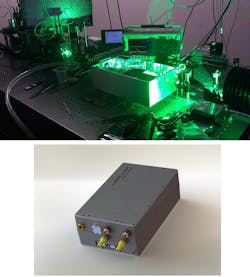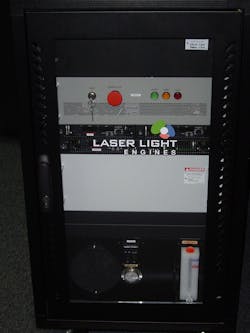PHOTONICS APPLIED: DISPLAYS: High-power RGB laser engine powers digital projection displays
BILL BECK and IAN LEE
Since the 1950s, high-end projection—in particular, cinema projection—has relied on xenon arc lamps to deliver the necessary illumination. These lamps use large amounts of energy, are costly, and require regular replacement. After years of research and development, laser illumination is now approaching commercial readiness for 2D and 3D cinema and for many other applications as well.
The first attempts to use laser illumination were for flight-simulator displays as early as 20 years ago. Trial systems were developed but failed on four counts: low power and efficiency, output at the wrong wavelengths, image-destroying speckle noise, and the lack of a suitable projection technology.
These problems are being solved through a combination of efficient, high-brightness, tunable red, green, and blue (RGB) laser technology; despeckling subsystems; and laser-illumination engines designed for high-performance digital projection systems. The result is a light source that has a long lifetime, eliminating the need for constantly changing expensive xenon lamps; and low power consumption, saving on lamp electricity as well as heating, ventilation, and air-conditioning (HVAC) operating costs.
More recently, the cinema industry has identified the need for a light source with triple the brightness of lamps to compensate for the large light losses inherent in all 3D cinema systems. As 3D deployments have accelerated the global conversion to digital cinema, it has become apparent that any commercial laser illumination system will have to be adaptable to the huge base of newly installed 2D and 3D systems.
Laser Light Engines (LLE) has combined mature laser and nonlinear optics technology to develop a universal, modular, high-power RGB light engine that eliminates laser-speckle noise and improves the image-quality standards of the industry. High beam quality enables efficient optical fiber delivery to any pre-installed digital cinema or similar-performance projector. This in turn will enable a radical new use model called "off-board illumination," which will become essential to many signage, simulation, and other multiprojector applications requiring remote, high-power light sources.
RGB laser engine requirements
Laser-projection applications range in output from 3000 lm (the practical upper limit for LED projection) to 100,000 lm (the limit for existing digital projectors). It should be noted that the range from 35,000 to 100,000 lm output is well beyond the limits of a xenon lamp in a digital projector and can only be achieved with lasers.
The required laser input power is a function of RGB wavelengths and projector throughput. Assuming optimized RGB primaries and good throughput, a combined RGB output power of 10 to 800 W is required to address the entire range of available applications. Target lifetimes of 20,000 to 50,000 hours are desirable.
A laser engine consists of seven subsystems: red, green, and blue color modules; controllable power supply; cooling; projector interface; and system control software. Multiple engines can be combined to address ultrahigh-brightness requirements such as IMAX screens or theme park attractions.
Tunable, despeckled green module
The requirements for a green laser color module suitable for cinema and display applications are unique. The power, spectral, cost, and lifetime requirements drive the design of such a module toward the use of innovative technologies. The LLE design incorporates several techniques for high efficiency and good thermal management such as intracavity frequency doubling and slab-geometry crystals.
The design approach we have taken uses neodymium-doped yttrium lithium fluoride (Nd:YLF) as the gain medium. This material choice affords a number of important advantages but is essential to LLE's laser-despeckling technology. A frequency-doubled Nd:YAG or vanadate (Nd:YVO4) laser cannot serve as an acceptable green source because it will not meet the extremely demanding image-quality requirements of Hollywood's digital cinema specifications.
Our baseline laser color modules scale diode-pumped, intracavity frequency-doubled, Nd:YLF lasers to 30- and 50-W-class green outputs. These lasers are Q-switched at high pulse-repetition rates. The beam quality is near diffraction limited with pulsewidths designed for driving additional nonlinear processes that enable despeckled output. A high beam quality leads to efficient and reliable small-diameter fiber delivery, which is critical to both retrofit installations and off-board illumination.
The LLE roadmap includes both high-power despeckled green modules and half-power modules for power-scaling increments and smaller systems. Our roadmap also includes dual-wavelength "super-despeckling" that utilizes both the sigma and pi Nd:YLF polarizations. Both power increments and drive wavelengths will be combined in the same standard 6.4 liter module.
Projection applications require compact, reliable, long-life laser color modules that can be integrated and controlled in a complete RGB engine. All variants are based on mature, 8xx nm pump diode bars. The laser module is fluid-cooled with a manifold integrated in the sealed, standard module housing. The laser itself uses only conduction-cooled components, which eliminates the potential for leaks. The design is simplified and parts count minimized for low-cost manufacturing.
Side-pumped slab architecture
Laser color modules are based on diode-bar side-pumped Nd:YLF slabs. This side-pumped architecture results in a distributed pump profile for the absorption path through the YLF gain medium. A nearly homogeneous thermal load on the gain crystal is achieved by optimizing the Nd doping level, pump wavelength, polarization, and thermal management. The slab footprint provides a large surface area for heat removal from the thin YLF slab, enabling near-one-dimensional thermal gradients and boosting conductive cooling of the slab, increasing pump power and system scalability.
The architecture uses a multipass lasing beam path through the slab to provide high gain, even at high pulse-repetition frequencies. The lasing mode is sized to match the collimated pump beam thickness and positioned through the Nd:YLF slab to provide good extraction efficiency of the stored energy from the pump diodes. Cavity mode size is controlled using weak cylindrical lenses.
Another advantage of Nd:YLF is that it exhibits low thermal lensing, enabling maximum pump power and thus very high green output per beamline. The natural birefringence of YLF reduces the need for birefringence compensation or problems from depolarization. The laser is acousto-optically Q-switched, which provides flexibility for control of the system.
The 1047 or 1053 nm light in the laser cavity is converted to green using intracavity frequency doubling through a lithium triborate (LBO) crystal. The relatively high peak power in the laser cavity optimizes output coupling with modest conversion efficiency per pass in the LBO but with very high overall conversion. As a result, short and low-cost LBO crystals with relatively large pump spot sizes can be used to convert the IR to green. Cavity design and material selection for lower-temperature LBO and maximum spot size reduce stress on coatings and crystals and thus maximize system reliability and lifetime.
Tunable red module
To maximize component use and production volume, the core laser-oscillator cavity in the same compact housing as the green module is used as the foundation of the red color module. It uses the identical diode-bar-pumped Nd:YLF laser to generate infrared (IR), but instead of LBO conversion to green, a sum-frequency-mixing (SFM) subsystem is incorporated to efficiently generate tunable, despeckled, short-wavelength red light. This source has tunable output at wavelengths shorter than 620 nm, providing substantially higher luminous efficacy than is currently available from 640 nm red diode sources.
The red color module is the same size and uses identical infrastructure as the green module. The use of dual red modules tuned to different spectral bands enables efficient spectral-filter-based 3D. Stacking of tunable, wideband red modules with adjacent spectral output bands can eliminate red speckle, even on silver 3D screens.
Blue color modules are based on fiber-coupled aggregations of mature, low-cost, multiwatt gallium nitride-based laser diodes, which are available over a wide range of wavelengths.
We use 523.5 nm and 526.5 nm outputs to drive an additional nonlinear process that allows tuning of the green color point. The red color point is tunable as well. Selectable primaries allow the same engine to be used for digital cinema, so-called "Rec 709" (a high-definition television format standard), or new laser-enabled wide-gamut color spaces, while always maximizing output lumens per input laser watt.
The laser engine includes standard RGB color modules in 12.6 × 4.1 × 7.9 in. housings (see Fig. 1). The color modules include the laser, diagnostic sensing, internal thermal control, and a logic and communications board that enables external engine and remote network control via Ethernet. The housing is designed for mounting two modules (resulting in more than 44,000 lm of despeckled green) side by side in a 2.5 RU standard 19 in. rack mount (14 in. deep). Standalone engines have their own external power supply and cooling system.
Laser color modules are assembled from small optical components that are precision template-bonded directly to the thermally stabilized housing; there are no mirrors to adjust or maintain. Parts-count reduction and assembly simplification was essential to meeting the commercial requirements of the digital-cinema standards.
Color modules and engines are networkable, which enables remote light-source management (long a goal of the cinema industry). Parameters such as RGB output power, color point, and white balance can be monitored, analyzed, and fed back to maintain long-term system brightness and image quality, which are capabilities that lamp-based projectors still lack (see Fig. 2).Other uses
A modular, scalable, fiber-delivered RGB laser light engine can have other display and lighting uses as well. For example, laser illumination can be delivered through optical-fiber cable to remote locations up to 300 ft from the solid-state light source, enabling many applications in bright, high-resolution, large-scale signage.
As with content, sound, and automation, light can now be rack-mounted in a server closet and delivered to multiple displays. There are also many pure lighting applications where laser illumination will be beneficial, such as in environments where lamp changes are impossible and electric wire is undesirable.
ACKNOWLEDGMENT
IMAX is a registered trademark of IMAX Corporation.
Bill Beck is the founder and executive vice president of business development and Ian Lee is the director of laser engineering at Laser Light Engines, 8C Industrial Way, Salem, NH 03079 USA; e-mails: [email protected] and [email protected]; www.laserlightengines.com.

